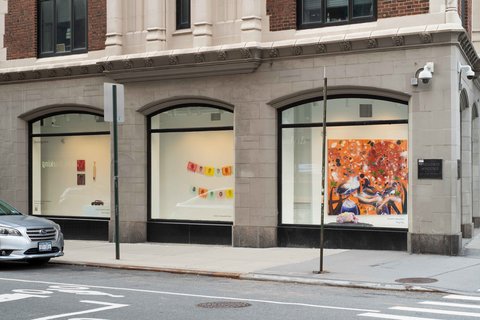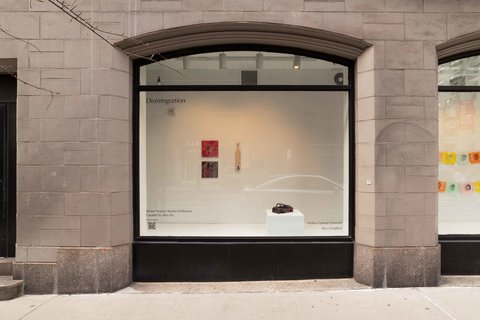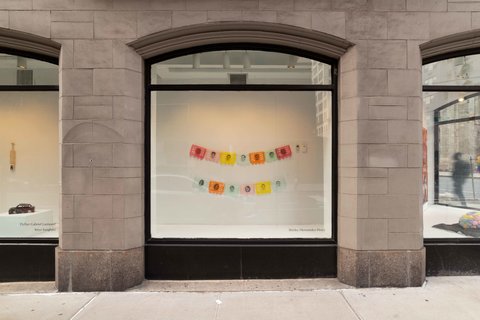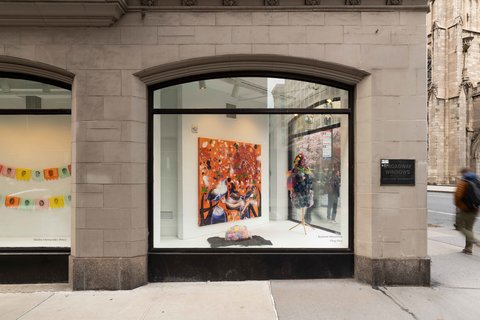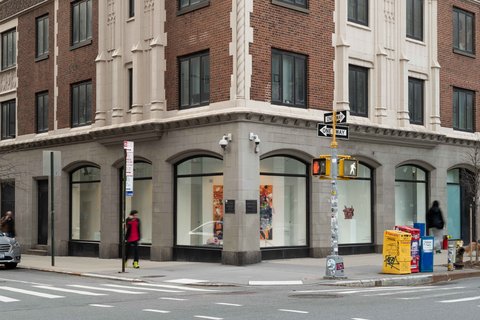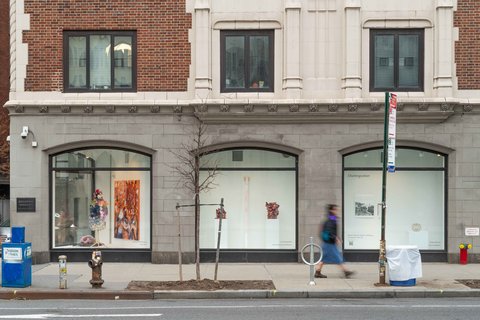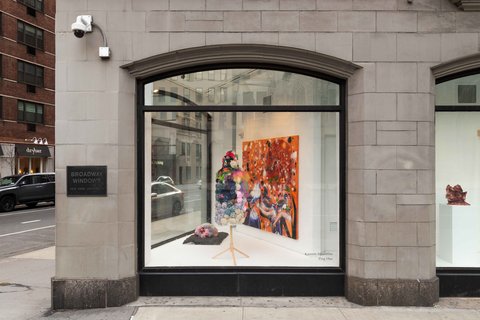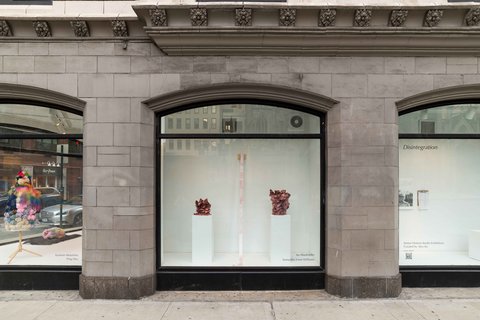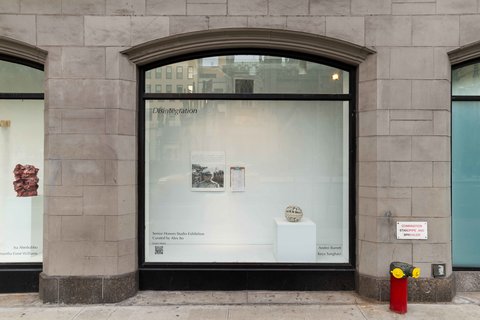Catalog Release Reception
80 Washington Square East
Thursday, April 10, 5–7PM
Isa Abedrabbo
Andrei Barrett
Shirley Hernandez-Perez
Ping Hsu
Dyllan Gabriel Larmond
Kareem Moumina
Keya Sanghavi
Samantha Esme Williams
Disintegration is a group exhibition curated by Alex Ito, and features the artwork of eight BFA Studio Art Majors in the final year of their undergraduate studies at the New York University Steinhardt School of Culture, Education and Human Development’s Department of Art & Art Professions.
Curated by Alex Ito
Organized by Erin Johnson - Director of Undergraduate Studies, Andrew Ordonez - Senior Honors & Studio Coordinator, Silvia Abisaab - Program Administrator and Studio Photographer, Phia Simoni - Senior Studio Operations Assistant, Howie Chen - Director, 80WSE Gallery, Jon Huron - Manager, 80WSE Gallery, Olivia Andrews - Exhibitions Coordinator, Jenny Noguchi - Publication Designer, Carter Seddon - Gallery Photographer
Thanks to Silvia Abisaab, Olivia Andrews, Jonathan Berger, Jesse Bransford, Tammy Lee Brown, Kyung-Me C, Ken Castronuovo, Howie Chen, Dana DeGiulio, Nancy Deihl, Monica Driscoll, Neil Goldberg, Hina Haider Fancy, Shadi Harouni, Jon Huron, Heidi Lau, Marlene McCarty, Kevin McCoy, Vonetta Moses, Lila Nazemian, Laurel Ptak, Erika Ranee, Linda Sormin
A special thanks to the Chen Cui Family Art Practice Fund for their continued support of the BFA Studio Art Program.
*Broadway Windows is a series of five street-level display windows located at the corner of Broadway and East 10th Street. The installations can be viewed 24 hours a day, seven days a week.
In an era defined by misinformation, a global health crisis, sociopolitical unrest, and a media landscape shaped more by algorithms than integrity, both collective and individual voices are heralded for their potential and scrutinized for their intent. The world has grown increasingly complex and unfamiliar, exposing the contradictions of our leaders and the biases within ourselves—laid bare for friends and strangers alike to witness, and for some, to despair. Today, the political reality of the United States feels less like the promise of an American Dream and more like a dystopian satire, where absurdity and consequence collide. The very foundations beneath us seem to be liquefying, grasping at our ankles like quicksand made of political nightmares, crumbling institutions, and commodified self-care. And yet, our heads remain above water, and our voices, however uncertain, can still persist.
Disintegration emerges from this moment of instability, an exhibition that confronts the shifting terrain of contemporary existence, where certainty dissolves, leadership falters, and the future feels increasingly unmoored. Pulling inspiration from Karl Marx’s famous assertion—“All that is solid melts into air, all that is holy is profaned, and man is at last compelled to face with sober senses, his real conditions of life, and his relations with his kind.”—the show explores how artists grapple with the erosion of stability in a post-pandemic, meme-saturated, and algorithmically governed world. Through works that engage with political discourse, personal interiority, and evolving identity, the exhibition illuminates new ways of forging human communication amid disillusionment and fatigue. These pieces remind us that perseverance is not a passive act but a movement—an insistence on speaking up, sharing space, and imagining beyond the constraints of the present. In a time when logic itself is shifting, and the familiar fractures into the surreal, the artists here reveal that the act of creation is, in itself, an act of resistance—one that encourages us to dream of an other, and perhaps, a world remade.
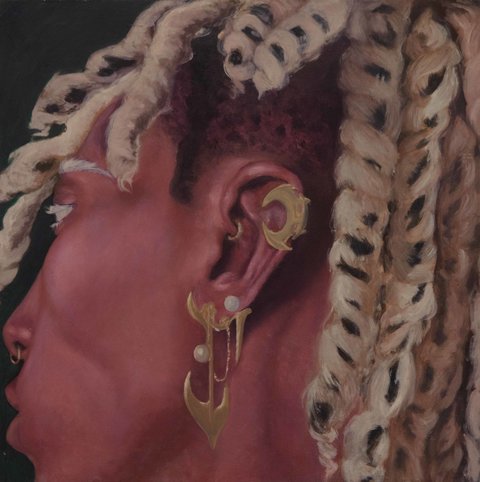
Beginning on East 10th Street, two windows display works by Dyllan Gabriel Larmond, Keya Sanghavi, and Shirley Hernandez-Perez. Larmond’s work captures the fluid and often contradictory nature of identity by diaristically rendering objects that hold deep personal and cultural significance. Through meticulous depictions of items like a fraternity paddle or swan scissors—objects tethered to both individual and communal histories—Larmond challenges the ways identity is externally perceived versus internally lived. Journal Entries II, created in Berlin during a time of personal upheaval, layers automatic writing in English, Spanish, and German over traces of material, forming an index of self that resists easy legibility. By foregrounding objects that carry both stigma and memory, Larmond invites viewers to reconsider connotation by questioning how meaning shifts over time. His engagement with materials—whether in painting or in the symbolic weight of a fraternity paddle referencing the country's first and only queer fraternity—acts as both a record and a reconfiguration of experience, creating space for difference while offering a deeply personal yet communal way of navigating identity’s ever-shifting terrain.
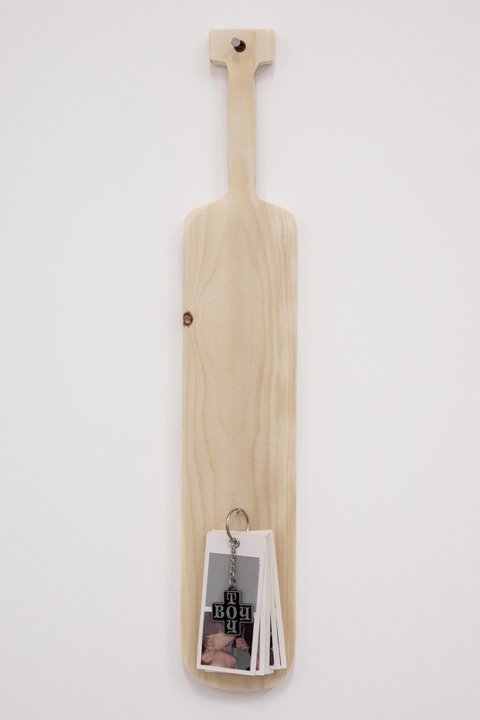.jpg)
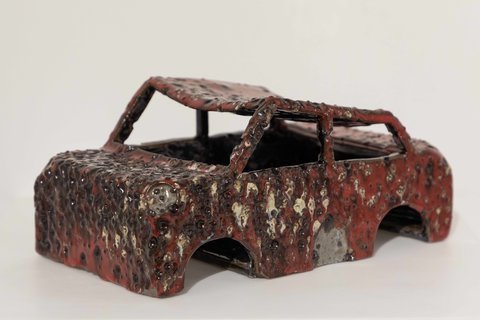
Paired with Larmond’s work is one of two ceramic sculptures by Keya Sanghavi. Sanghavi’s ceramic works embrace vulnerability as a quiet force, transforming personal history into a language of reflection and redemption. Her pieces, abstract yet deeply intimate, navigate the complexities of relationships—how they shape, strengthen, and sometimes weaken us. There is a tension between what is revealed and what is withheld; in To All the People I’ve Called Home #6 (shown in the Broadway windows), the work evokes a sense of knowing yet remaining at a distance, mirroring the emotional contradictions of toxic relationships. In To All the People I’ve Called Home #4, a specific memory and person become embedded in the material, yet their presence remains just out of reach, an invitation rather than an explanation. The unpredictable nature of clay—its fragility, its resistance, its transformation in the kiln—parallels the artist’s process of working through memory, allowing space for both control and surrender. For the viewer, this withholding generates discomfort, a necessary pause to consider how personal histories and societal expectations shape the ways we navigate the world. Sanghavi unfolds the bittersweet moments that can (re)define a life, offering a space to sit with discomfort, to reflect, and to recognize the quiet power of emotional openness.
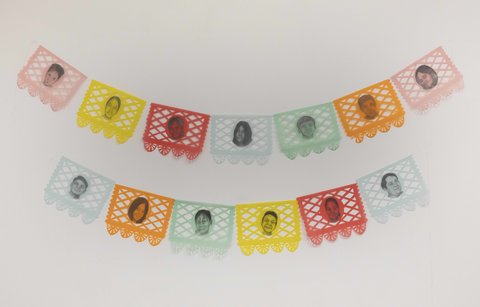
In the adjacent window resides the work of Shirley Hernandez-Perez. Hernandez-Perez’s Untitled bridges personal loss and collective mourning, bringing visibility to the mass disappearances in Mexico through a delicate yet powerful material language. Inspired by the disappearance of her brother in Mexico nearly a decade ago, the work features portraits of children missing in Mexico on colored vellum, evoking both the fragility of memory and the weight of absence. Drawing from her Mexican-American heritage, the vellum incorporates papel picado—a traditional craft used in celebrations and mourning—as a means of honoring these lives while critiquing the bureaucratic neglect that allows such tragedies to persist. The intricate, hand-cut forms reflect the precarity of the situation, mirroring the vulnerability of those lost and the families left searching. By transforming a symbol of festivity into an act of remembrance, the artist creates a space where grief, resistance, and cultural identity intertwine. The piece is intended to keep growing with more drawings on vellum, speaking to the overwhelming scale of the crisis, reinforcing that these lives cannot be forgotten, even as institutions fail them. Through color, material, and symbolism, Hernandez-Perez ensures that both her personal and cultural histories remain central to unfolding tragic and marginalized discussions.
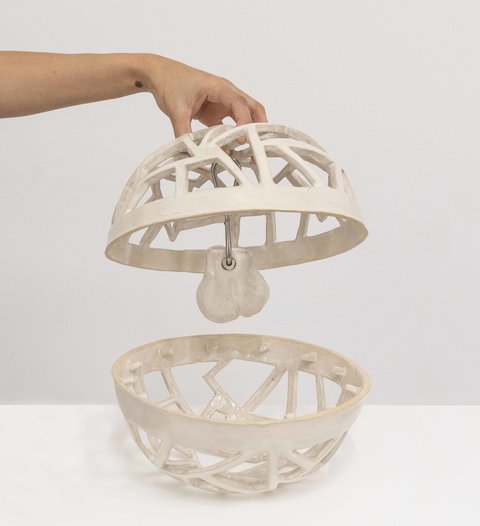
Around the corner in the first two windows on Broadway are the works of Andrei Barrett (paired with Sanghavi’s To All the People I’ve Called Home #6), Samantha Esme Williams, and Isa Abedrabbo. Barrett’s I posted this on Facebook in 2014 after falling in love with my summer camp swimming instructor within a week because he was nice to me transforms the fleeting, overshared nature of internet culture into something intimate and materially grounded. Reinterpreting the aesthetics of the meme, shitpost, and Tumblr overshare, Barrett replaces the digital ephemerality of these forms with the slow, deliberate act of graphite drawing. The piece depicts the artist as a child at a Boy Scout summer —an environment steeped in heteronormative masculinity—overlaid with the text of the title, humorously exposing the tension between personal queer desire and the rigid social frameworks of such spaces. Installed alongside the drawing is the camp program clipped to a clipboard that anchors the memory in historical time, emphasizing a material record of an experience often mediated through digital spaces. In contrast to Hito Steyerl’s concept of the poor image—a degraded, infinitely circulated digital file—Barrett resists mechanical reproduction, instead creating a labor-intensive rendering that reclaims personal history, while speaking to the virtual spaces in which these experiences are shared, distributed, and left open to public use. By translating a common internet vernacular into something tactile and deeply personal, the work carves out space for queer self-narration, challenging cis-heteronormativity while fostering a collective language for those navigating similar experiences.
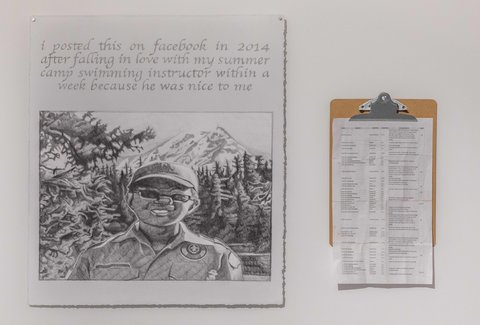.jpg)
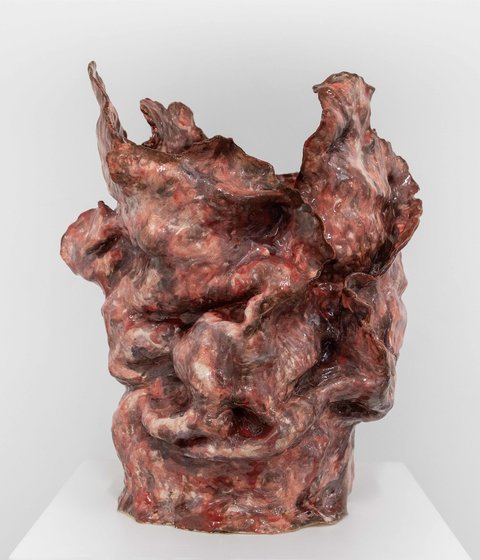
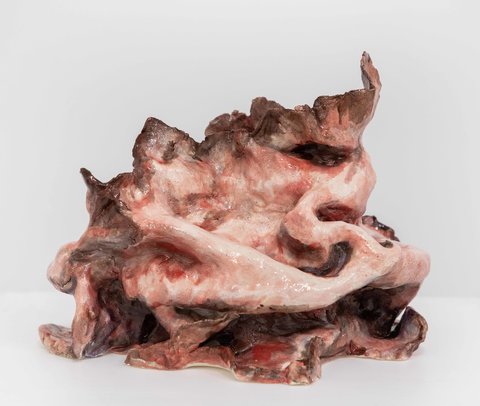
In the next window, Samantha Esme Williams’s ceramic works give form to the unseen—pain, disability, and the will to exist within those frameworks—by transforming personal experience into flesh-like ceramic objects. Rooted in her struggle with endometriosis, a condition of cumulative tissue growth, her works reject traditional notions of function, utility, and bodily expectations. These vessel-like forms, though hollow, refuse to act as containers, subtly challenging the societal perception of the disabled female body as something defined by its productivity or reproductive capacity. The performative nature of their making mirrors the artist’s own physical struggle; working with extra-wet, unstable clay, Williams allows the material’s resistance to echo her body’s own limitations. The finished pieces stand vertically, almost confrontational in their presence, yet they evoke an empathetic relationship with the viewer—monuments to pain, resilience, and the raw state of being. By capturing and freezing these gestures through the firing process, Williams monumentalizes the tension between control and surrender, offering a powerful meditation on the lived experience of disability and the permanence of its often invisible impact.
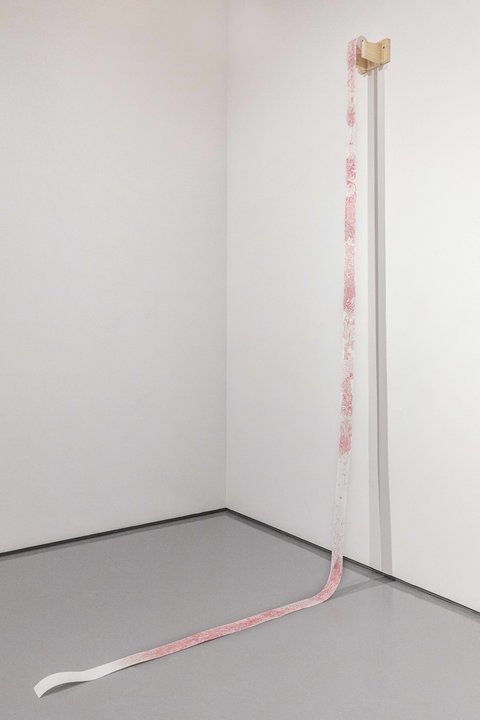
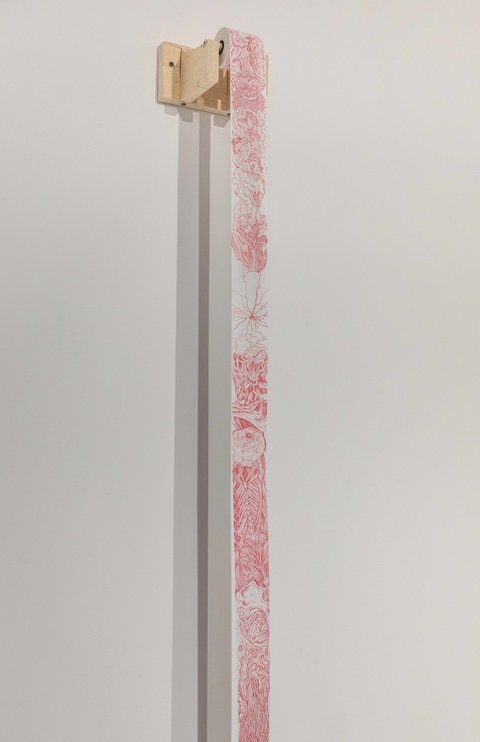
Isa Abedrabbo's Payments in Red materializes grief, rage, and the overwhelming inconceivability of ongoing violence through a fragile yet unrelenting form. Abedrabbo's work gives shape to the indescribable and traces historical cycles of violence. Using receipt paper, a material associated with transactions and data, and anatomical drawings of the human body, the piece interrogates how human suffering is often reduced to economic and political abstraction. The long, unspooling scroll suggests both a record and a wound, its continuous length evoking the scale and persistence of loss. Payments in Red speaks to the artist's Palestinian heritage, embodying both personal and collective grief. The piece is not just a document, but a refusal to accept violence as inevitable. Through its materiality, the work invites the viewer to confront the weight of what is often dismissed as distant or impersonal, transforming abstraction into something impossible to ignore.
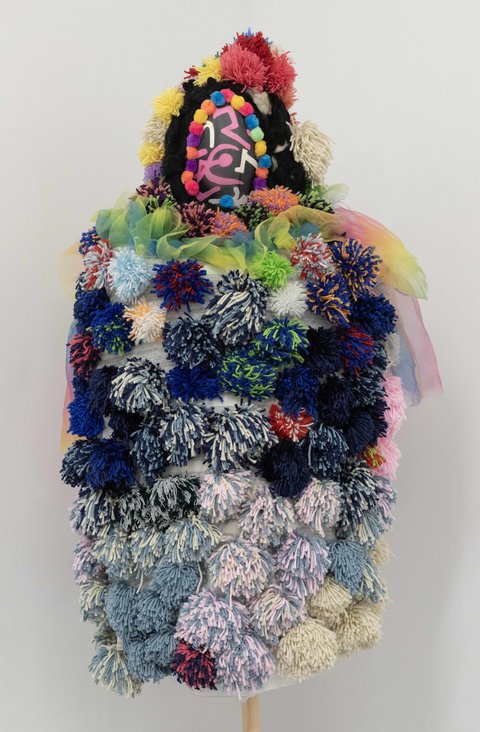
The East 10th Street and Broadway windows intersect in the final corner window, hosting works by Kareem Moumina and Ping Hsu. In Ping Hsu’s Chin’s Bio Project materiality is a tool that bridges differences, inviting connection through softness, color, and the unthreatening energy of cuteness. Composed of sculptural fiber creatures and a bodysuit worn by the artist in everyday life, the work creates a shared space of recognition—where otherness is not a barrier but an invitation. As a transgender artist, Hsu engages with the ways perception shapes experience, using the bodysuit as both a form of joyful expression and a means of deflecting discriminatory behavior. Rather than provoking fear or resistance, the work fosters curiosity and dialogue, offering an alternative to cultural bias and bigotry. Drawing on the symbolism of skin as a universal commonality—whether human, animal, fruit, or alien—the project presents otherness as inherent to all, challenging the hierarchies that define who or what is considered valid, worthy, or real. Through these soft, biomorphic companions, Hsu constructs an ecosystem of care, reimagining the community as something fluid, expansive, and built upon mutual recognition rather than exclusion.

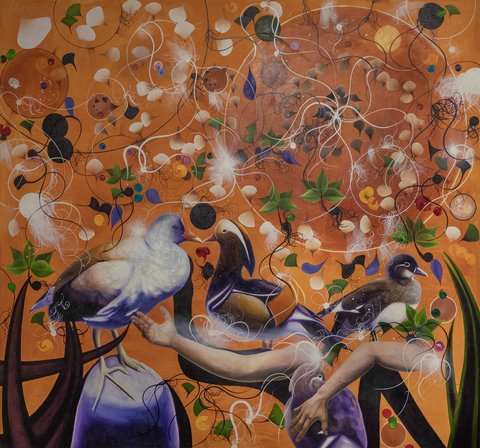
Kareem Moumina’s Echoes of Connection meditates on the delicate and often ambiguous relationship between humanity and the natural world, exploring both our interventions and responsibilities within it. Through dreamlike compositions, Moumina constructs an intricate visual dialogue between ecosystems, spirituality, and form. His work is driven by a fascination with color, shape, and illusion, yet these formal qualities are inseparable from the subconscious and cultural forces that shape artistic expression—his dreams, filled with both harmony and chaos, become blueprints for an idealized world, while memories from his Filipino and Saudi Arabian background become entangled in visual balance. Circles within the painting encapsulate distinct yet interconnected spaces, symbolizing transformation and coexistence. While Moumina’s work does not explicitly engage with sociopolitical critique like other artists in the exhibition, it serves as a bridge—alongside Ping Hsu’s fantastical creatures—for communication through fantasy, reminding us that dreams, both personal and collective, remain vital tools for understanding and reshaping the world around us.
These works were selected not only for their artistic merit but also for how they open up social possibilities, demonstrating how contrasting ideological frameworks and subject positions can coexist, challenge, and ultimately enrich one another. In a time marked by urgency and uncertainty, the ability to find solidarity with others is not just a matter of critical thought, but also a recognition that the agency to speak up is always possible. It is through agency—expressed in both small and significant actions—that we create room to think beyond normative frameworks and invite others into an exercise toward openness. The artworks in the exhibition remind us that the courage to strengthen our voices is not only an act of resistance but a way to challenge and reform the limitations imposed by dominant structures. In this space of inquiry, we open possibilities for a world where difference is embraced, and the power to disrupt and disintegrate those frameworks belongs to all.
– Alex Ito, Curator
